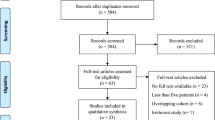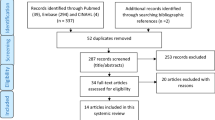Abstract
Purpose
Surgical repair of large hernia defects requires detailed pre-operative planning, particularly in cases with loss of domain. This situation often hampers mid-line reconstruction, even after component separation, when the size of the hernia is disproportional to the volume of the abdominal area. In this case, other strategies may be needed to place the viscera back into the abdominal cavity after reducing the hernia sac. The administration of botulinum toxin prior to the surgical procedure has been indicated as an adjunct for more complex cases. This results in stretching of the lateral musculature of the abdomen, allowing midline approximation. In addition, the application of botulinum toxin alone has been investigated as a means of downstaging in the management of ventral hernias, thereby precluding component separation and enabling primary closure of the midline by placement of mesh within the retromuscular space using the Rives Stoppa technique.
Methods
Systematic review of the literature for observational studies involving patients undergoing pre-operative application of botulinum toxin for ventral hernia repair was conducted according to the PRISMA guidelines.
Results
Advance of the lateral musculature of the abdomen by an average of 4.11 cm with low heterogeneity, as well as low rates of surgical site infection (SSI), surgical site occurrences (SSO) and recurrence, was shown.
Conclusion
Pre-operative application of botulinum toxin for ventral hernia repair promoted an increase in the length of the lateral musculature of the abdomen which can help improve the outcomes of morbidity and recurrence.








Similar content being viewed by others
Data Availability
The data that support the findings of this study are openly available in the references.
References
Slater NJ, Montgomery A, Berrevoet F, Carbonell AM, Chang A, Franklin M et al (2013) Criteria for definition of a complex abdominal wall hernia. Hernia 18(1):7–17. https://doi.org/10.1007/s10029-013-1168-6
Sanders DL, Kingsnorth AN (2012) The modern management of incisional hernias. BMJ 344:e2843. https://doi.org/10.1136/bmj.e2843
Poulose BK, Shelton J, Phillips S, Moore D, Nealon W, Penson D et al (2012) Epidemiology and cost of ventral hernia repair: making the case for hernia research. Hernia 16(2):179–183. https://doi.org/10.1007/s10029-011-0879-9
Lutz W, Sanderson W, Scherbov S (2008) The coming acceleration of global population ageing. Nature 451(7179):716–719. https://doi.org/10.1038/nature06516
Prentice A (2004) Storing up problems: the medical case for a slimmer nation. Clin Med (London) 4(2):99–101. https://doi.org/10.7861/clinmedicine.4-2-99
Eriksson A, Rosenberg J, Bisgaard T (2014) Surgical treatment for giant incisional hernia: a qualitative systematic review. Hernia 18(1):31–38. https://doi.org/10.1007/s10029-013-1066-y
Patel SV, Paskar DD, Nelson RL, Vedula SS, Steele SR (2017) Closure methods for laparotomy incisions for preventing incisional hernias and other wound complications. Cochrane Database Syst Rev 11(11):005661. https://doi.org/10.1002/14651858.CD005661.pub2
Huu Nho RL, Mege D, Ouaïssi M, Sielezneff I, Sastre B (2012) Incidence and prevention of ventral incisional hernia. J Visc Surg 149(5 Suppl):e3–e14. https://doi.org/10.1016/j.jviscsurg.2012.05.004
Soltanizadeh S, Helgstrand F, Jorgensen LN (2017) Botulinum toxin A as an adjunct to abdominal wall reconstruction for incisional hernia. Plast Reconstr Surg Glob Open 5(6):e1358. https://doi.org/10.1097/GOX.0000000000001358
Ramirez OM, Ruas E, Dellon AL (1990) “Components separation” method for closure of abdominal-wall defects: an anatomic and clinical study. Plast Reconstr Surg 86(3):519–526. https://doi.org/10.1097/00006534-199009000-00023
Novitsky YW, Elliott HL, Orenstein SB, Rosen MJ (2012) Transversus abdominis muscle release: a novel approach to posterior component separation during complex abdominal wall reconstruction. Am J Surg 204(5):709–716. https://doi.org/10.1016/j.amjsurg.2012.02.008
Rives J, Lardennois B, Pire JC, Hibon J (1973) Les grandes éventrations. Importance du "volet abdominal" et des troubles respiratoires qui lui sont secondaires [Large incisional hernias. The importance of flail abdomen and of subsequent respiratory disorders]. Chirurgie 99 (8): 547–563.
Stoppa R, Petit J, Henry X et al (1972) Plastie des hernies de l’aine par voie médiane sous-péritonéale. Actualités Chirurgicales, 74th Congres Français de Chirurgie. Masson, Association Française de Chirurgie. Paris, pp 448–453
Haskins IN, Horne CM, Krpata DM, Prabhu AS, Tastaldi L, Perez AJ (2018) A call for standardization of wound events reporting following ventral hernia repair. Hernia 22(5):729–736. https://doi.org/10.1007/s10029-018-1748-6
Tanaka EY, Yoo JH, Rodrigues AJ Jr, Utiyama EM, Birolini D, Rasslan S (2010) A computerized tomography scan method for calculating the hernia sac and abdominal cavity volume in complex large incisional hernia with loss of domain. Hernia 14(1):63–69. https://doi.org/10.1007/s10029-009-0560-8
Suchý T, Bernardová M, Svĕtlík M, Vojtaník P (2001) Visceroredukce v operacním resení “nemozných” obrovských brisních kýl [Visceral reduction in surgical treatment of “impossibly” large abdominal hernias]. Rozhl Chir 80(9):473–476
Raynor RW, Del Guercio LR (1989) The place for pneumoperitoneum in the repair of massive hernia. World J Surg 13(5):581–585. https://doi.org/10.1007/BF01658874
Sanclemente MCL, Robres J, Cano ML, Barri J, Lozoya R, López S et al (2013) Neumoperitoneo preoperatorio progresivo en pacientes con hernias gigantes de la pared abdominal [Progressive preoperative pneumoperitoneum in patients with giant hernias of the abdominal wall]. Cir Esp 91(7):444–449. https://doi.org/10.1016/j.ciresp.2012.08.004
Van Geffen HJAA, Simmermacher RKJ (2005) Incisional hernia repair: abdominoplasty, tissue expansion, and methods of augmentation. World J Surg 29(8):1080–1085. https://doi.org/10.1007/s00268-005-7972-0
Mcadory RS, Cobb WS, Carbonell AM (2009) Progressive preoperative pneumoperitoneum for hernias with loss of domain. Am Surg 75(6):504–509
Zendejas B, Khasawneh MA, Srvantstyan B, Jenkins DH, Schiller HJ, Zielinski MD (2013) Outcomes of chemical component paralysis using botulinum toxin for incisional hernia repairs. World J Surg 37(12):2830–2837. https://doi.org/10.1007/s00268-013-2211-6
Dressler D (2012) Clinical applications of botulinum toxin. Curr Opin Microbiol 15(3):325–336. https://doi.org/10.1016/j.mib.2012.05.012
Bueno-Lledó J, Martinez-Hoed J, Torregrosa-Gallud A, Menéndez-Jiménez M, Pous-Serrano S (2020) Botulinum toxin to avoid component separation in midline large hernias. Surgery 168(3):543–549. https://doi.org/10.1016/j.surg.2020.04.050
Ministério da Saúde (2012) Diretrizes metodológicas: elaboração de revisão sistemática e metanálise de ensaios clínicos randomizados. Brasília, Editora do Ministério da Saúde.
Kumar NG, Faqih AA, Feng MP, Miller RS, Pierce RA, Sharp KW et al (2017) Using quality improvement principles to enhance long-term completion of patient-reported outcomes after ventral hernia repair. J Am Coll Surg 224(2):172–179. https://doi.org/10.1016/j.jamcollsurg.2016.10.031
Timmer AS, Claessen JJM, Atema JJ, Rutten MVH, Hompes R, Boermeester MA (2021) A systematic review and meta-analysis of technical aspects and clinical outcomes of botulinum toxin prior to abdominal wall reconstruction. Hernia 25(6):1413–1425. https://doi.org/10.1007/s10029-021-02499-1
Tashkandi A, Bueno-Lledó J, Durtette-Guzylack J, Cayeux A, Bukhari R, Rhaeim R et al (2021) Adjunct botox to preoperative progressive pneumoperitoneum for incisional hernia with loss of domain: no additional effect but may improve outcomes. Hernia 25(6):1507–1517. https://doi.org/10.1007/s10029-021-02387-8
Elstner KE, Read JW, Saunders J, Cosman PH, Rodriguez-Acevedo O, Jacombs ASW et al (2020) Selective muscle botulinum toxin a component paralysis in complex ventral hernia repair. Hernia 24(2):287–293. https://doi.org/10.1007/s10029-019-01939-3
Catalán-Garza V, Peña-Soria MJ, Sáez-Carlin P, Cabeza-Gómez JJ, García-Fernández A, Torres-García AJ (2020) Long-term results of botulinum toxin type A in complex abdominal wall repair and review of the literature. Updates Surg 72(4):1201–1206. https://doi.org/10.1007/s13304-020-00775-w
Chan DL, Ravindran P, Fan HS, Elstner KE, Jacombs ASW, Ibrahim N et al (2020) Minimally invasive venetian blinds ventral hernia repair with botulinum toxin chemical component separation. ANZ J Surg 90(1–2):67–71. https://doi.org/10.1111/ans.15438
Yurtkap Y, van Rooijen MMJ, Roels S, Bosmans JML, Uyttebroek O, Lange JF et al (2021) Implementing preoperative Botulinum toxin A and progressive pneumoperitoneum through the use of an algorithm in giant ventral hernia repair. Hernia 25(2):389–398. https://doi.org/10.1007/s10029-020-02226-2
Deerenberg EB, Shao JM, Elhage SA, Lopez R, Ayuso SA, Augenstein VA et al (2021) Preoperative botulinum toxin A injection in complex abdominal wall reconstruction- a propensity-scored matched study. Am J Surg 222(3):638–642. https://doi.org/10.1016/j.amjsurg.2021.01.010
Bueno-Lledó J, Torregrosa A, Ballester N, Carreño O, Carbonell F, Pastor PG et al (2017) Preoperative progressive pneumoperitoneum and botulinum toxin type A in patients with large incisional hernia. Hernia 21(2):233–243. https://doi.org/10.1007/s10029-017-1582-2
Rodriguez-Acevedo O, Elstner KE, Jacombs ASW, Read JW, Martins RT, Arduini F, la, (2018) Preoperative Botulinum toxin A enabling defect closure and laparoscopic repair of complex ventral hernia. Surg Endosc 32(2):831–839. https://doi.org/10.1007/s00464-017-5750-3
Canario DAH, Isaacson AJ, Martissa JA, Stewart JK (2021) Ultrasound-guided chemical component separation with botulinum toxin A prior to surgical hernia repair. J Vasc Intervent Radiol 32(2):256–261. https://doi.org/10.1016/j.jvir.2020.09.013
Nielsen MO, Bjerg J, Dorfelt A, Jørgensen LN, Jensen KK (2020) Short-term safety of preoperative administration of botulinum toxin A for the treatment of large ventral hernia with loss of domain. Hernia 24(2):295–299. https://doi.org/10.1007/s10029-019-01957-1
Bueno-Lledó J, Torregrosa A, Jiménez R, Pastor PG (2018) Preoperative combination of progressive pneumoperitoneum and botulinum toxin type A in patients with loss of domain hernia. Surg Endosc 32(8):3599–3608. https://doi.org/10.1007/s00464-018-6089-0
Elstner KE, Read JW, Rodriguez-Acevedo O, Cosman PH, Dardano AN, Jacombs AS et al (2017) Preoperative chemical component relaxation using botulinum toxin A: enabling laparoscopic repair of complex ventral hernia. Surg Endosc 31(2):761–768. https://doi.org/10.1007/s00464-016-5030-7
Jacombs A, Elstner K, Rodriguez-Acevedo O, Read JW, Ho-Shon K, Wehrhahn M et al (2022) Seven years of preoperative BTA abdominal wall preparation and the Macquarie system for surgical management of complex ventral hernia. Hernia 26(1):109–121. https://doi.org/10.1007/s10029-021-02428-2
Elstner KE, Read JW, Rodriguez-Acevedo O, Ho-Shon K, Magnussen J, Ibrahim N (2017) Preoperative progressive pneumoperitoneum complementing chemical component relaxation in complex ventral hernia repair. Surg Endosc 31(4):1914–1922. https://doi.org/10.1007/s00464-016-5194-1
López A, Rubalcava EJV (2016) Infiltración de toxina botulínica en la preparación preoperatoria de las hernias con defectos de 10 cm (y hasta 15 cm). Revista Hispanoamericana de Hernia 4(2):43–49. https://doi.org/10.1016/j.rehah.2016.02.003
Bueno-Lledó J, Carreño-Saenz O, Torregrosa-Gallud A, Pous-Serrano S (2020) Preoperative botulinum toxin and progressive pneumoperitoneum in loss of domain hernias-our first 100 cases. Front Surg 7:3. https://doi.org/10.3389/fsurg.2020.00003
Author information
Authors and Affiliations
Contributions
DERM is the main author and contributed to search literature, data extraction, software, and formal analysis. RGZ contributed to search literature and data extraction. Amaral PH performed editing and validation. MJZ, CJCP and PLGA contributed to editing and methodology. MCA performed editing and supervision. RS contributed to editing, supervision and project administration and is the third reviewer.
Corresponding author
Ethics declarations
Conflict of interest
None.
Ethical approval
The present study was a systematic literature review in which no research involving humans was undertaken, and no permit from the local Research Ethics Committee for Research in Humans was required.
Additional information
Publisher's Note
Springer Nature remains neutral with regard to jurisdictional claims in published maps and institutional affiliations.
Rights and permissions
Springer Nature or its licensor (e.g. a society or other partner) holds exclusive rights to this article under a publishing agreement with the author(s) or other rightsholder(s); author self-archiving of the accepted manuscript version of this article is solely governed by the terms of such publishing agreement and applicable law.
About this article
Cite this article
Dias, E.R.M., Rondini, G.Z., Amaral, P.H.F. et al. Systematic review and meta-analysis of the pre-operative application of botulinum toxin for ventral hernia repair. Hernia 27, 807–818 (2023). https://doi.org/10.1007/s10029-023-02816-w
Received:
Accepted:
Published:
Issue Date:
DOI: https://doi.org/10.1007/s10029-023-02816-w




